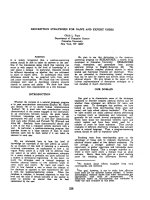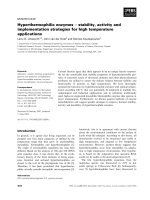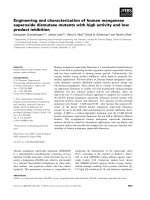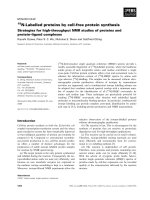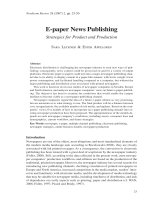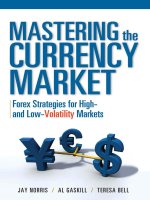Forex Strategies for High and Low Volatility Markets_4 potx
Bạn đang xem bản rút gọn của tài liệu. Xem và tải ngay bản đầy đủ của tài liệu tại đây (1.14 MB, 32 trang )
sell-offs or price breaks. It is this dynamic occurrence, or behav-
ioral change, that experienced traders can see. This often is
referred to as “feeling” a market, as in “that last leg up didn’t
feel right to me.” Even without seeing the volume histogram
at the bottom of the chart, experienced traders notice when a
market is starting to waver at minor resistance levels or drops
faster than it had been dropping on reactions. Head and shoul-
ders formations are great times to notice these subtle changes
in price behavior because, like triple tops and triple bottoms,
they take time to play out, giving us time to observe and
understand the changing dynamics.
Mastering the Currency Market
148
Figure 6-16 Head and Shoulders Top
Figure 6-16 shows a head and shoulders top in the U.S. stock
market that played out in 2007 and 2008. We can see from the
volume pattern on the chart how trader participation dried up
for the last leg up to create the head and then picked up as the
market sold off in November. By the time price penetrated the
neckline, there was little doubt about who was in control of this
market from the price action and volume: the bears. After a cli-
mactic sell-off in January, the market snapped back and
retested the original breakout area.
Rising and Falling Wedges
A rising wedge is a bearish formation that usually is seen as a
reversal pattern but also can be a continuation pattern. Here we
will focus on reversal patterns. A rising wedge can be seen on
the charts as an up move with a wide shape that gradually
narrows as it rises, giving it a cone shape. It can be tricky to
identify as being bearish because it exhibits the higher lows and
higher highs that are the hallmark of an uptrend. What helps
us identify it as a reversal formation is the decreasing volume
on each successive rally. Regardless of whether we see it as a
bearish development, by following basic trendline analysis we
will be able to see when the formation breaks out, or down,
by the way it penetrates the support line that helps identify it.
Figure 6-17 shows a rising wedge on the weekly USDCAD chart
that built up through the second half of 2001 and culminated
with a major reversal in early 2002.
A falling wedge is a bullish formation that usually is seen
as a reversal pattern but also can be a continuation pattern.
Here we will focus on reversal patterns. It can be seen on the
Chart Patterns
149
charts as a down move with a wide shape that gradually
narrows as it falls, giving it a cone shape. Like a rising wedge,
it can be tricky to identify as being bullish because of the
lower highs and lower lows. Again, what helps us identify
it as a reversal formation is the decreasing volume on each
successive sell-off. By following trendline analysis, we should
be able to identify the breakout or point of reversal when it
penetrates the resistance line that borders its upper range.
There is no way to project a price objective for this formation.
Figure 6-18 shows a falling wedge on a weekly EURJPY chart
Mastering the Currency Market
150
Figure 6-17 Rising Wedge
that culminates with a double bottom in the fourth quarter of
2000 just before a powerful reversal and rally.
The pattern-recognition techniques we’ve outlined can come
in handy in analyzing and trading the financial markets. When
taken in the context of the candlestick charts, support and
resistance levels, and trendlines we have studied, the prospect
of forecasting market movement should start to seem like
a very real possibility. Knowing that we are likely to see price
continuation patterns more often than actual price reversal
Chart Patterns
151
Figure 6-18 Falling Wedge
patterns should give us an edge over less educated analysts
and traders. In summary, we can say that basic price patterns
and volume indicators are essential in the study of technical
analysis and will bring us closer to melding market analysis
with our intuition.
Mastering the Currency Market
152
CHAPTER
Technical
Indicators
A
myriad of technical tools, studies, and overlays are avail-
able to analysts and traders, and it is our goal to define
those which are readily available on most charting packages
and those which we use or know are used by other profes-
sionals in the trading community. In this section we will cover
only those indicators which are derived from price. A techni-
cal indicator is a tool that uses a series of data points and var-
ious mathematical formulas to define a perspective on market
behavior. The primary data points used are an individual
period’s open, high, low, and closing price. Despite what most
analysts believe, technical indicators were not designed to pre-
dict future price movement as much as to define current price
movement. Each type of indicator has a different formula and
varies in its degree of sophistication. It is believed by most
experienced money managers and traders that the simplest for-
mulas often lead to the most successful trading.
153
7
Leading and Lagging Indicators
The term leading indicator is somewhat of a misnomer in that
there is no tool that can predict what will happen in the future.
Previous and current price behaviors are generally the only
determinants in technical analysis. For the sake of analysis,
however, technical indicators can be divided into two types:
leading indicators and lagging indicators. A leading indicator
gives us an indication or signal before an actual price reversal;
a lagging indicator gives us an indication or signal after a new
trend has started. The first thing one needs to understand about
this concept is that trades that are based on a leading indicator
probably are going to have a higher losing percentage because
the indicator is anticipating price behavior. In contrast, with a
lagging indicator we wait for behavior that indicates that a
reversal has occurred, and that new trend is already under way
before we commit to a trade. Most leading indicators measure
momentum, or the degree of the slope of a current price move-
ment—i.e., the speed of the trend—and are called momentum
oscillators. Momentum in markets ebbs and flows, and an indi-
cator that lets us know whether the speed of the market is accel-
erating or slowing is a handy tool to have because larger price
changes usually are accompanied by higher price momentum.
A market can be making lower lows and lower highs and be in
an obvious downtrend, but if the rate of its descent is slowing
and we have a position that is going with the trend, we may
want to pay closer attention to price. We would take additional
confirmation from individual candle behavior and support
lines. Similarly, if the rate of acceleration is increasing in our
favor, we would be more inclined to maintain our position.
Mastering the Currency Market
154
Direction constitutes important information, but measuring
momentum, particularly as a market approaches support
or resistance, has predictive value. Leading indicators include
stochastics, the Relative Strength Index (RSI), and the Com-
modity Channel Index (CCI). Most trend-following indicators,
or “overlays,” such as moving averages and moving average
crosses, are considered lagging indicators as they are giving us
the price’s previous and current direction. Indicators based on
previous price action cannot alert us to a change of direction
until after the market has experienced it. An advantage of this
is that we are inclined to stay with positions longer. It is thought
by many experienced traders that the most important skill a
trader can have and the one that is the hardest to achieve is the
ability to “let a profit run,” or stay in a position longer and max-
imize profits. Two of the main reasons for this are emotions,
generally nervousness, and leading indicators. Trend traders
need to be comfortable with lagging indicators. Lagging indi-
cators other then moving averages include moving average
convergence/divergence (MACD) and Bollinger bands.
Lagging Indicators
Moving Averages and Crosses: Simple and Exponential
Moving averages are lagging indicators that are overlaid on
the price chart and are used primarily to help traders identify
a trend’s direction, provide support or resistance, and gener-
ate trade signals. A simple moving average (SMA) is a chart
overlay that provides a smoothed average of the closing prices
or opening prices for a particular period. A simple moving
Technical Indicators
155
average is calculated by adding together a specific number of
bars’ or candles’ closing prices and dividing that sum by the
total number of time periods to get an average price. The for-
mula for a five-period moving average is
SMA ϭ (C1 ϩ C2 ϩ C3 ϩ C4 ϩ C5) Ϭ 5
Figure 7-1 shows a five-period simple moving average taken
for EURUSD in summer 2008. As each candle is completed on
the chart, a new average point is plotted so that over time the
average moves forward, following price. The shorter-term the
time frame covered by the moving average is, the more sensi-
tive the moving average becomes and the choppier the line
becomes. The longer-term the moving average is, the more
Mastering the Currency Market
156
Figure 7-1 Five-Period Simple Moving Average
desensitized it becomes and the smoother the line becomes.
The moving average is used to smooth out actual price action
in an effort to make the trend easier to spot. When price is trad-
ing above the moving average points, the trend is said to be
higher, whereas price trading below the moving average indi-
cates that the trend is lower. Some analysts use longer-term
moving averages such as 100-period and 200-period averages
as support or resistance. Longer-term averages also are used to
generate signals in several ways. If the close is above or below
a particular moving average, a buy or sell signal may be gen-
erated. A moving average cross is formed by using two sepa-
rate averages that are based on two different time frames that
then are used both to confirm trending price action and to gen-
erate trade signals. Figure 7-2 is a chart of the S&P 500 stock
index futures contract from the fourth quarter of 2007 through
Technical Indicators
157
Figure 7-2 Fifty-Period and 200-Period Simple Moving Average
the third quarter of 2008 with a 50-period and a 200-period
simple moving average overlay.
When the shorter-term average crosses below the longer-
term one, it is a sell signal and the trend is presumed to be
down; similarly, when the shorter-term average crosses above
the longer-term one, it is a buy signal and the trend is said to
be up. Similarly, if price is above the moving averages, the
trend is said to be up, and if price is below the moving aver-
ages, it is down.
The cross of the 50-day SMA below the 200-day SMA in late
December 2007 in Figure 7-2 provides a well-timed sell trigger.
Such long-term averages are not sensitive and will keep you in
a trade for an extended period; that can be trying, as was the
case in March through May when the market rallied but
rewarding from mid-May till mid-July as the market fell off
and made a new low for the year. Note how the 50-day SMA
provided a pivotal level in March and April and again in late
May and how the 200-day SMA provided a good resistance
level in May. Professionals tend to use 50-day and 200-day
SMAs when they are analyzing or trading securities.
The exponential moving average (EMA) is a moving aver-
age overlay that puts more weight on the most recent closing
prices to make it more responsive to newer incoming price
data. Currency traders often use 89-period and 144-period
exponential moving averages simultaneously for their long-
term charts, considering a crossover of the two averages an
important signal. When the shorter-term average crosses below
the longer-term one, it is a sell signal and the trend is presumed
to be down; when the shorter-term average crosses above the
longer-term one, it is a buy signal and the trend is said to be
up. Similarly, when price is above the moving averages, the
Mastering the Currency Market
158
trend is considered up, and when price is below the moving
averages, the trend is considered down.
It is important to remember that moving averages and their
crosses are lagging indicators, meaning that the trend must
change before the longer-term moving average crosses will
confirm it. Thus, they are more suited for trading longer-term,
and traders who use them should be prepared to weather
significant drawdowns as they often give a signal after a large
move, leaving the position open in the face of initial correc-
tions. It is important to understand that it is at the beginning
of trend changes that corrections and price swings tend to be
at their biggest, making the longer-term averages and crosses
more analytic tools than trading tools for more experienced
traders. Long-term exponential moving averages also are used
as support or resistance levels.
Technical Indicators
159
Figure 7-3 An 89-Period and a 144-Period Exponential Moving Average Cross
In Figure 7-3 we have an 89-period and a 144-period EMA
cross that generates a sell signal on the daily chart. This signal
proved very profitable 18 months later, but it gave the trader a
sizable drawdown 6 months into the trade. Another way
moving averages can prove useful is by acting as support or
resistance levels once a trend is established, as can be seen in
Figure 7-3 when the moving averages provide resistance in
August and September 2007.
A drawback of moving averages is that they can distract a
trader from focusing on simple isolated highs and lows and
trendlines, which give a trader excellent information in a
timely manner.
Oscillators
An oscillator is a set of data that moves back and forth, or oscil-
lates, between two points. The oscillators we will discuss in this
chapter are MACD, stochastics, RSI, CCI, and parabolic stop
and reverse (SAR).
MACD
The moving average convergence/divergence (MACD) is a ver-
satile indicator that combines a trend-following function with
a centered oscillator, also known as a momentum indicator. By
developing MACD, a derivative of moving averages, Gerald
Appel gave us a hybrid tool that is helpful in determining pres-
ent direction and measures momentum (the rate of change in
price). Although it may look very similar to a moving average,
the MACD is actually a tool that shows the divergence of two
Mastering the Currency Market
160
moving averages. The parameters of the MACD are expressed
as follows:
MACD “A, B, C”
where
A ϭ the number of bars in the fast moving average
B ϭ the number of bars in the slow moving average
C ϭ the number of bars used to calculate the difference
between the two averages
A typical MACD ratio is 12, 26, 9. The change of two moving
averages either closer to or farther away from each other has pre-
dictive value. As the moving averages approach each other in
value, a potential crossover may be forming, meaning that the
momentum of the current trend is slowing and the market may
be getting ready to change trend direction. Similarly, as a trend
strengthens, the moving averages grow farther apart, indicating
an increase in momentum. In Figure 7-4, the MACD is shown at
the bottom of a price chart. Note that there is both a linear com-
ponent and a histogram component (shown as a series of verti-
cal bars). The black line represents the MACD, which is the
average of the differences between two moving averages. The
heavy line is the fastest-moving component. The lighter line is
an average of the MACD over nine periods, and it is a slower-
moving component. The two lines move closer to and farther
away from each other over time, and occasionally they cross.
The histogram shows the variation in the distance between
the fast-moving and slow-moving components and makes
Technical Indicators
161
crossovers easier to visualize. When the MACD was introduced,
it consisted of only the MACD line. The trigger line and the his-
togram components were added later by Thomas Aspray.
The MACD histogram measures momentum. When the bars
on the histogram are moving away from zero, that is inter-
preted as positive momentum; when they are moving toward
the zero line, momentum is decreasing. Positive momentum
indicates that the current trend is strengthening, and negative
momentum indicates that it is weakening. A shift in the MACD
histogram, such as a decrease after a series of increases in a
price uptrend or an increase after a series of decreases in a price
downtrend, can be seen as the first indication of a potential
shift in price direction, or trend.
The MACD and MACD histogram generate buy or sell sig-
nals, or trade filters, in several different ways, including
Mastering the Currency Market
162
Figure 7-4 Construction of the MACD
MACD centerline crossover, MACD moving average crossover,
MACD histogram shift, and both MACD and MACD his-
togram divergence.
MACD Centerline Crossover
A centerline crossover occurs when the black MACD line
crosses over the zero line, or centerline. For the GBPUSD
chart in Figure 7-4, which covers the last quarter of 2007 and
the first five months of 2008, we have overlaid the 12-period
and 26-period moving averages so that you can visualize one
aspect of what the MACD is showing: a crossover of the
12-period and 26-period moving averages. The black line of
the MACD moving below the zero line coincides with the
12-period average moving below the 26-period average, both
of which are sell signals. The black line of the MACD moving
above the zero line generates a buy signal. It is this zero line
cross that represents an important indication, as we can see
from the direction GBPUSD took after these signals in 2007
and 2008.
MACD Trigger Line Crossover
Figures 7-5 and 7-6 show the MACD as it crosses over its trigger
line; this is known as a moving average crossover or an MACD
cross. When the MACD is below its trigger line, it supports a
short position; when it is above the trigger line, it supports a long
position. The MACD crossing its trigger line can be useful for
identifying price extremes and can be used to exit trend trades
and enter countertrend trades. Combined with the oscillator
function, a crossover of the two lines in proximity to the zero line
Technical Indicators
163
Mastering the Currency Market
164
Figure 7-5 MACD Trigger Line Cross
Figure 7-6 Trigger Line Cross as Trend and CounterTrend
provides additional information about whether a trigger is in the
direction of the current trend. A black line cross below the gray
line that occurs below the zero line would indicate a sell signal
in the direction of the predominant trend, whereas a black line
cross above the gray line below the zero line would be a coun-
tertrend buy signal. Figure 7-5 is a daily chart of USDCHF from
late winter to early spring 2008.
When there is a black line cross above the gray line above
zero, it is a trend buy signal; a black line cross below the gray
line above zero is a countertrend sell signal. Figure 7-6 shows
a 240-minute chart of USDCHF from September 2007. Thus,
although the zero line cross by the black line is still the most
influential signal because it is a trending signal, we also have
the MACD-trigger line cross, which can be both a trend signal
and a countertrend signal.
MACD Histogram
The rate of change between the two lines (the MACD and the
trigger line) also provides an indication of the strength of a
move and is represented by the vertical bars, or histograms, that
populate the centerline of the indicator. If the distance between
the two lines is increasing, the move under way is considered
strong and the histogram will be marked by successively higher
bars; if the distance between the two lines is decreasing, the
momentum of the move is waning and the histogram will
record shorter bars. This information is valuable in deciding to
let a profit run if the MACD histogram is increasing in the direc-
tion of a trade. Similarly, if you are in a trade and the histogram
is moving against your position, it is a warning that price
momentum is starting to work against your position.
Technical Indicators
165
MACD Divergence
Another way the MACD functions is to show signals called
divergence. Divergence occurs when a price is going in one
direction and the MACD or another momentum-measuring
indicator is not confirming that direction. Price can be making
lower lows, but if the rate of change is slowing over time, it
will show up as higher lows or even a flattening MACD. This
can telegraph a price pause or even a price reversal. This is
known as positive divergence between price and the MACD.
Figure 7-7 shows an example of positive divergence in the
USDCHF in spring 2007.
Negative divergence occurs when price is still rising but
the MACD and the trigger line are moving sideways or falling.
Mastering the Currency Market
166
Figure 7-7 Positive Divergence as Measured by MACD
In strong market moves it is not uncommon to see double or even
triple divergence before seeing a significant correction or rever-
sal. As a rule of thumb, divergence over a shorter period is more
powerful than divergence over a longer period. Think of diver-
gence as a development that indicates that a market needs to take
a break. It is reasonable to consider that there will be times in
a bear market when a market becomes oversold, momentum
starts to wane, and a correction is needed. Price technically still
is moving lower, but momentum is slowing. Price may backtrack
and test resistance before continuing on. Although most market
reversals exhibit divergence before they turn, they also exhibit
this behavior just before normal consolidation periods.
Technical Indicators
167
Figure 7-8 Negative Divergence as Measured by MACD
In Figure 7-8, which is a 240-minute chart of GBPUSD from
September 2008, we have an example of negative divergence
before a market turn and sell-off.
Figure 7-9, a chart of EURJPY from the second half of 2006,
shows the many roles MACD can play in market analysis. We
see a prominent resistance level just above 150.00. The market
is respecting both the bull trendline and the resistance level.
In September and October the market goes flat and starts to
wrap around its monthly central pivot in black. In early
November it’s safe to say that we don’t know which way the
market will break out. The MACD, however, did give us a hint
of the rally to come by staying above the zero level. Note also
how once the rally kicked off in earnest in late November, the
Mastering the Currency Market
168
Figure 7-9 MACD and Support and Resistance
MACD accelerated away from the trigger line. This shows that
the difference between the two lines was increasing. This was
a powerful signal telling traders to maintain their long posi-
tions. After reading about chart patterns, we can see that in
Figure 7-9 there is an ascending triangle, which is a bullish
continuation pattern.
In our analysis we also will see divergence between the
MACD histogram and price. Just as the divergence between
price and the MACD line can be significant, the divergence
between the histogram and price also can be significant (see
Figure 7-10).
Traders often ask, “Which divergence should we look for,
that between the MACD cross (the black and gray lines) and
price or that between the MACD histogram and price?” The
Technical Indicators
169
Figure 7-10 Divergence on MACD and MACD Histogram
answer is either one; however, short-term divergence generally
will show up first on the histogram and can be more significant.
After gauging the current price trend on the chart, we look
for the direction of the MACD to confirm that trend. We
gauge the momentum of that trend through the MACD
histogram. We are also aware of which side of the zero line
MACD is on. For trade signals we want to have the MACD
histogram moving in the same direction as the trade. Once
in the trade, we monitor the MACD histogram, and if
momentum exists, we stay in the trade to let the profit run. If
we get a MACD cross against our position on the same time
frame we took the signal on, we almost certainly will take that
as a signal to exit the trade.
To summarize, we use the MACD to identify trends as well
as possible turning points or shifts in momentum and to keep
us in a trend trade longer. For countertrend trades we look for
divergence between the MACD and/or the MACD histogram
and price. Before entering a trade, we always want to know the
MACD’s stance relative to the zero line and the direction of the
MACD and its trigger line.
Bollinger Bands
Bollinger bands were developed by John Bollinger as a way to
incorporate volatility and price by using an 18-period simple
moving average to help define price and trend and a 2 standard
deviation measurement both added to and subtracted from the
18-period SMA to gauge potential volatility. This tool is made
up of three bands that are used in an attempt to encompass the
majority of a market’s price action. The number of periods in
an SMA and the width of the standard deviations are variables
Mastering the Currency Market
170
that can be changed in accordance with your trading plan to
give wider or tighter ranges. Because a simple moving average
is at the center of this market overlay, this is considered a lag-
ging indicator.
Bollinger bands generally are not known as a signal-generat-
ing tool but as a trading aid for identifying low volatility or rang-
ing periods in a market and for identifying price extremes
brought on by high volatility. A narrowing of the bands can iden-
tify a market that may be one to watch for a breakout. Widening
of the bands or high volatility is seen when price penetrates the
outer band, and that can be interpreted as a hint to take a profit
or exit a market that may be approaching unsustainable levels
for that particular period. When price closes above or below the
moving average at the center of the bands—generally an 18-SMA
or 20-SMA—this can be taken as a directional bias.
Technical Indicators
171
Figure 7-11 Bollinger Bands with Double Narrows
You also can layer two different Bollinger bands on the same
price chart by adjusting the SMA and the standard deviation
measurement. By coupling a shorter time frame EMA that has
smaller deviations with an 18-SMA that has a 2 standard
deviation Bollinger band, we may be tipped off sooner
that a desirable setup is in the making. Figure 7-11 shows a
shorter-term Bollinger band in gray narrow down ahead of the
longer-term Bollinger band in black. The double narrows is
telling us that the flow, or volatility, is likely to pick up in the
coming candles, or bars, which it does.
Bollinger bands are useful in that an analyst or trader can
scan any number of charts and markets in a short time in an
effort to home in on setups she finds favorable on the basis of
her experience.
Parabolic Stop and Reverse
The parabolic stop and reverse (parabolic SAR) is a tool for set-
ting a trailing stop; it was created by Welles Wilder, the developer
of the RSI. The calculation used is too complex to cover here, but
the concept is very simple. The SAR indicator provides a dotted
line above or below price to place your stop to either exit a posi-
tion or enter a new position, that is, stop and reverse. There are
two variables for setting up the indicator. The first is the step,
which calculates where the stop initially should be placed, and
the second is the maximum step, which controls the increment
adjustment of the SAR point as price moves. Wilder suggested a
step setting of 0.02 and a maximum step setting of 0.20, and that
is what most charting packages default to. The higher the step
setting is, the more sensitive the price point will be.
Mastering the Currency Market
172
